Susan Joy Rennison's
Website

|
|

Financial System
Black Swan - Imminent!
30th January 2024
|
|
His Dark Materials
(One story in three volumes)
Author
Philip Pullman, 1995, 1997, 2000
Click each image for Amazon.com publisher details and book reviews.
Click above for a short summary and free online book contents
Storyline Introduction
Philip Pullman's epic tale of a wayward child starts in an alternate world that is similar to Earth. The heroine is Lyra Belacqua, a young girl who has been given shelter by the scholars at Jordan College at Oxford University, and her "dæmon," Pantalaimon, are caught snooping in the Headmaster's rooms by her Uncle. (In Lyra's world, dæmons are the external forms of people's souls.) However, Lyra and Pantalaimon had learnt that Lord Asriel, Lyra's uncle, is about to be poisoned by the Headmaster and they warn Lord Asriel in time to save his life. Later, whilst being forced to continue hiding in the Headmaster's wardrobe, they overhear Lord Asriel telling the scholars in a meeting about a strange substance he is researching called "Dust." Lord Asriel is able to convince the scholars to fund his further explorations of Dust, which require him to travel to the northernmost reaches of the globe. All of this greatly excites Lyra's curiosity about Dust.

Actor Daniel Craig as Lord Asriel at a meeting with scholars at Jordan College, Oxford.
|
|
Later, mysterious kidnappers whom Lyra and her friends call "Gobblers" take Lyra's best friend, an Oxford boy of servants named Roger Parslow. Lyra wants to go look for Roger, but before she can, a woman named Mrs. Coulter, who appears initially to be some kind of benefactress, spirits her away to London. Before Lyra leaves Oxford, the Headmaster gives her a strange device called an alethiometer that looks like a sophisticated golden compass. Only a few trained specialists know how to use this device, but she assumes her job is to pass it on to her Uncle Lord Asriel.
|
Actress Dakota Blue Richards as the wayward Lyra Belacqua playing with mud with her dæmon Pantalaimon.
|
|
Arriving in London, Lyra is at first enchanted by the Mrs. Coulter, but Lyra's rebellious nature, as well as her suspicions about Mrs. Coulter's vicious dæmon, lead her to flee Mrs. Coulter's house. Lyra wants to go north and learn more about Dust. Before she can make any plans, she falls in with the Costas, a family that is part of a clan of people known as Gyptians, who live in boats and travel on the rivers. The Costas are concerned as they have also lost a boy to the Gobblers. When the Costas take Lyra to meet John Faa, the king of the Gyptians, she finds out that they are planning an expedition north in search of the Gobblers and the missing children. From her meeting with John Faa, Lyra learns that Ma Costa (the mother of the Costa family) looked after her when she was a baby and that Lord Asriel is her father and Mrs. Coulter is her mother. Lyra convinces the Gyptians to take her north with them on their quest to recover the captured children. Lyra's world is depicted as being very similar to the Victorian era.
|
|
Nicole Kidman and Dakota Blue Richards as Mrs Coulter and Lyra Belacqua at social function.
|
Pullman's Success and Loathing
When Philip Pullman started his tale of a wayward child caught hiding in wardrobe, he thought it would appeal to a few clever kids and a few adults, but he was wrong. In 2007, His Dark Materials had been translated into 40 languages and had sold 15 million copies. Pullman's His Dark Materials is in the same genre as C.S. Lewis's Chronicles of Narnia, Tolkien's Lord of the Rings and J.K. Rowling's Harry Potter series, all of these book series are about other worlds that seem very realistic. There are lots of reviews, articles, summaries and opinions about these books and the general plot should be read before this book review will make any sense. I can recommend the Spark Notes Plot Overview. There is a large cast of characters besides the main heroine Lyra Belacqua but her special friend Will Parry, only appears in the second part of the trilogy.
Most reviews for adults, suggest that Pullman's books have an anti-church and anti-theistic themes and general reading will inevitably lead to finding out why some want these books banned. The UK Guardian gives us a flavour of the tumult that this trilogy has caused. Thus, we read:
The novelist and children's writer Philip Pullman has been showered with awards that include a CBE, a Carnegie Medal and several honorary professorships. This week he notched up a new distinction: he is ranked second in the top 10 books that people have tried to ban across America.
Pullman's fantasy trilogy, His Dark Materials, has leapt to the top of the target list of would-be censors in the new rankings issued this week by the American Library Association. It tracks cases where individuals or groups have attempted to have books stripped from bookshelves in schools and libraries across the US.
Children's writer Philip Pullman ranked second on US banned books list
Author of His Dark Materials trilogy included on American Library Association's 2008 list,
The Guardian, 30th September 2009
When reached by the Guardian, Pullman quipped that he was "very glad to be back in the top 10 banned books" and seemed to be delighted. It is very clear that Pullman has made Lyra's world that is dominated by the Magisterium, very similar to the oppressive and intolerant church authorities active in the Middle Ages who terrorised, condemned and killed in the name of God. Thus the reaction to this exposé by those who think the Church is above criticism is highly predictable.
|
The Focus on 'Dust'
The point of this review is to focus on the book's theme of Dust. Most settle on Dust (please excuse the pun) as being dark matter and consciousness, but the trilogy also describes this Dust as being golden energy. This gives us a direct comparison with New Agers currently working with New Energy available on this planet. My Tuning the Diamonds: Electromagnetism & Spiritual Evolution book explains the arrival of New Energy being delivered by space weather and since 2006, NASA scientists have started to murmur via NASA press releases that Earth is experiencing a new stream of dark matter. Hence, it is useful to analyze Pullman's beliefs that he has coded into his now incredibly famous trilogy. Pullman's belief is especially pertinent as he states Dust falls from space on all worlds, but when there is a change in the flux of this Dust there are major consequences.
|
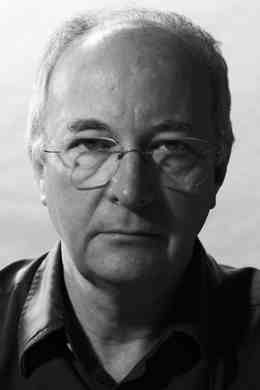
Children's writer Philip Pullman
|
|
Pullman also reveals where in the heavens this Dust comes from, but he complicates this by referring to Dust as angels, but not in the traditional sense because the book also features traditional angels too. Whatever, he tells us the Dust comes from the constellation of Ophiuchi. This is highly interesting as space scientists claim that a new stream of uncharged interstellar matter is entering our solar system from the direction of this constellation, but we can surmise this is not ordinary cosmic matter and that not all streams of cosmic energy are the same.
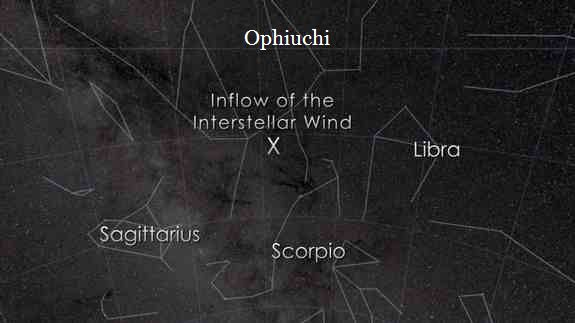
NASA spacecraft are monitoring an interstellar wind coming from the constellation Ophiuchus. Astrologers, or those interested in the historical development of astrology, will point out that some systems include a thirteenth sign of the zodiac known as Ophiuchus Serpentarius, the Serpent Holder. This constellation lies between Sagittarius and Libra, somewhat over Scorpio.
Before we get into the heavy subject of Dust, it is worth mentioning about book titles. In the United States, The Golden Compass became the title of the first book, instead of Northern Lights. There is some logic with this as The Golden Compass, The Subtle Knife and The Amber Spyglass, each book refers to an object in relation to Dust: There is Lyra's alethiometer, that looks like a kind of compass that can tell the truth, Will's knife which can cut windows between worlds, and Dr Mary Malone's spyglass which enables her to see Dust. As you can appreciate, if this logic was properly maintained, the first book should have been called The Alethiometer. Besides not making sense to people because it is a made up word, the Alethiometer is a play on words as it is an instrument that works by picking up æther to provide the answers to life's questions.
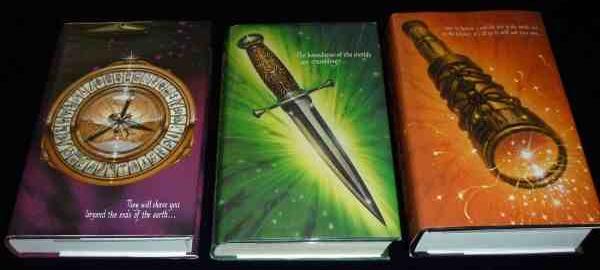
His Dark Materials bookcovers with illustrations of The Alethiometer, The Subtle Knife and The Amber Spyglass as objects with of major importantance to the understanding of Dust and pursuits of the main characters.
Incidentally, The Northern Lights or more usually called the Aurora Borealis in the northern hemisphere, are more like a background theme to this book. The main significance for the emphasis on the lights is that particles from space and especially from the Sun that arrive as part of the solar wind, are directed by the Earth's magnetic field into the Earth's atmosphere. In the trilogy, the lights are considered to be magical as they reveal the flimsiness of the layer that separates worlds. The witches play in the lights and angels pass between worlds in places like the aurora, where the layers between worlds are thinner. It is beneath the aurora borealis that Lord Asriel opens up a breach into another world. In the light of the aurora borealis, Dust is also more visible.
Since, most scientists scoff at the notion of æther but secretly know it exists, (please note the quote in my Tuning the Diamonds: Electromagnetism & Spiritual Evolution book by Dr Dennis Sciama from Cambridge, "We all believe in the æther, but we call it space-time"), Pullman as a storyteller can ride rough shot and point blank tell us what he really thinks. However, he compensates by providing a more acceptable scientific terminology and viewpoint through his character Dr Mary Malone. Another point I would like to make is this series is not really for small children as Pullman states it was an intentional version of Paradise Lost for teenagers. Pullman studied English literature at Oxford University and focused on the work of the seventeenth-century poet and essayist John Milton. The title of Pullman's trilogy, His Dark Materials, comes from a phrase in Milton's epic poem Paradise Lost, which retells the biblical story of Adam and Eve and their fall into sin and this masterpiece is a re-telling of the same story but with a twist.
Finally before, we go into depth about Dust, we have to appreciate Pullman's 'invention' of dæmons that in Lyra's world, make the difference between human beings and animals. In an interview with Pullman we are given the author's perspective and we are told:
In the novels Pullman dramatises this shift from innocence to experience through the device of dæmons. Everyone has a dæmon or animal spirit: when you are young, the dæmon keeps changing shape; as you get older your dæmon settles into a constant form. The dæmons are the single most brilliant idea in the books. Pullman got the idea from paintings by Leonardo da Vinci ("The Lady with the Ermine"), Holbein ("The Lady and the Squirrel") and Tiepolo ("Young Woman with a Macaw"), where there seems to be a psychological link between the person and the creature. Six years earlier, in his children's story "Spring-Heeled Jack", he prefigures this idea with a mournful moth who flutters around as the villain's conscience. The first four words of His Dark Materials, "Lyra and her dæmon...", are the four most important in the trilogy. Everything follows from that.
The Art of Darkness: An Interview with Philip Pullman, December 3rd 2007, More Intelligent Life
But on some analysis of these books, dæmons seem to represent more than the nondescript term 'soul'. It is more apt to see the dæmon as a representative of our nature/passions or our passionate selves. The reviews that point to our sexual nature or sexual feelings as the summation of the soul are being too simplistic. Pullman describes the role of a dæmon in different ways, but he specifically highlights a lack of imagination and curiosity for people without a fully functioning soul or dæmon. In the first book, The Northern Lights/The Golden Compass, the nurse at Bolvanger is cited as an example. People without a fully functioning dæmon or soul become docile and lack will power.
|
|
Pullman removes any doubt about the role of a dæmon and provides the compelling comparison of zombie soldiers. In the story, the witch queen Serafina Pekkala makes enquiries at the witch consulate in the north and discovers some rather unpleasant facts. She is told:
"They say that the Magisterium is assembling the greatest army ever known, and this is an advance party. And there are unpleasant rumors about some of the soldiers, Serafina Pekkala. I've heard about Bolvangar, and what they were doing there - cutting children's dæmons away, the most evil work I've ever heard of. Well, it seems there is a regiment of warriors who have been treated in the same way. Do you know the word zombi? They fear nothing, because they're mindless. There are some in this town now. The authorities keep them hidden, but word gets out, and the townspeople are terrified of them."
[The Subtle Knife, Chp 2, Among the Witches, pg 42]
|

Actress Eva Green as witch queen Serafina Pekkala and her snow-goose dæmon Kaisa.
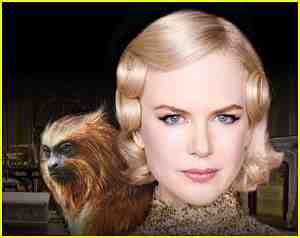
Actress Nicole Kidman playing Mrs Coulter with her golden monkey dæmon on her shoulder
|
|
Marisa Coulter has a body guard of these zombie soldiers and one of her lovers, Lord Boreal, asks about them. We are given the following synopsis.
"But tell me about your curious bodyguards, Marisa. I've never seen soldiers like that. Who are they?"
"Men, that's all. But... they've undergone intercision. They have no dæmons, so they have no fear and no imagination and no free will, and they'll fight till they're torn apart."
[The Subtle Knife, Chp 9, Theft, pg 199]
According to Pullman, zombies are people who have lost their passions or their passionate soul and therefore cannot attract Dust, shadow particles, or golden energy... What's more, by using the made-up term intercision, Pullman makes a direct comparison with excision which surgically means the complete removal of an organ, tissue, bone or tumour from a body. More specifically, he wants to draw our attention to the practice of female circumcision or cutting, that involves cutting out or operating on the genitalia of boys and girls in order to conform to cultural or religious traditions or beliefs. Personally, I can't see this as a topic of discussion for children, but the main point is to make a direct comparison to the religious practice of stopping people feeling (sexual) pleasurable sensations, because feeling allows us to attract more Dust. The point is laboured again and we get a scene where the witch Ruta Skadi explains to the other witches the horrors all over the world she has seen committed in the name of the Magisterium, the all powerful Church in Lyras's world. Pullman writes:
"I have travelled in the south lands. There are churches there, believe me, that cut their children too, as the people of Bolvangar did – not in the same way, but just as horribly. They cut their sexual organs, yes, both
boys and girls; they cut them with knives so that they shan't feel. That is what the Church does, and every church is the same: control, destroy, obliterate every good feeling."
[The Subtle Knife, Chp 2, Among the Witches, pg 50]
The Magisterium wants, people unresponsive and indifferent to all sorts of feeling, but especially sexual feelings. Mrs Coulter, who is also Lyra's mother, acts as an agent for the Magisterium and is in charge of the experiments at Bolvanger where kidnapped children are experimented on. She explains her beliefs to Lyra as follows:
"Darling, no one would ever dream of performing an operation on a child without testing it first. And no one in a thousand years would take a child's dæmon away altogether! All that happens is a little cut, and then everything's peaceful. Forever! You see, your dæmon's a wonderful friend and companion when you're young, but at the age we call puberty, the age you're coming to very soon, darling, dæmons bring all sort of troublesome thoughts and feelings, and that's what lets Dust in. A quick little operation before that, and you're never troubled again. And your dæmon stays with you, only...just not connected. Like a...like a wonderful pet, if you like. The best pet in the world! Wouldn't you like that?"
[The Northern Lights/The Golden Compass, Chp 17, The Witches pg 282 - 283]
|
|
What she means by "troublesome feelings" is of course sexual desire. Quite frankly, I am amazed Pullman does not go the whole gamut and give us a quick run down on the heretical esoteric sexual practice of Hieros Gamos, or Sacred marriage ritual. but maybe he decided to refrain as this is supposed to be a children's book.... Obviously, those who are quick on the uptake, will realise some profound esoteric beliefs are being simply explained, rightly or wrongly here.
|

|
|
Even though most claim that Pullman's concept of a dæmon is an invention, some research suggests otherwise and I can cite the mystical and esoteric works of the poet William Butler Yeats, an influential Irish writer who received the Nobel Prize for Literature in 1923. He even adopted the magical motto, dæmon est Deus inversus (A demon is a god reflected). What's more, the indigenous worldwide shamanic culture on this planet, refers to the existence of power animals. Wikipedia has a short summary about power animals and we read:
Power animal, is a broadly animistic and shamanic concept that has entered the English language from anthropology, ethnography and sociology. A tutelary spirit guides, helps or protects individuals, lineages and nations. In the shamanic worldview, everything is alive, bearing an inherent virtue, power and wisdom. In this context power animal(s) represent a person's connection to all life, their qualities of character, and their power.
The term "power animal" was generally introduced into contemporary language in 1980 by anthropologist Michæl Harner, Ph.D., in his classic work The Way of the Shaman, pp.57-72, 76-103.[1]
Power animals are common to shamanic practice in both Eurasia and the Americas. They are the helping or ministering spirit or familiar which empowers individuals and is essential for success in any venture undertaken.
In the shamanic worldview, most persons have power animals or tutelary spirits which empower and protect them from harm, like guardian spirits or angels in the Abrahamic Traditions. In these traditions, the power animal may also lend its ward or charge the wisdom or attributes of its kind.
There are plenty of other sources besides Wikipedia that provide similar details.... So, in our world, shamans can see power animals and know they exist. The implications are the existence of occult, secret knowledge or simply not well known information held by various groups, that makes Pullman's version of dæmons excruciatingly interesting....
Dust, Dust, Glorious Dust
Dust is the central theme of Philip Pullman's His Dark Materials, the motivating factor for the overall plot and the general excuse for some epic battles. Most of the main characters are to some extent engaged in the quest to understand Dust, either to destroy it or to preserve it, whilst providing the philosophical explanations for all the great mysteries. The first clear reference to Dust in the trilogy is in its relationship to growth and maturity. Dust is described as "elementary particles that don't interact in any way with others – very hard to detect, but the extraordinary thing is that they seem to be attracted to human beings", but much more strongly to those who have gone through puberty. [Northern Lights/The Golden Compass Ch 5. pg 89 ]
Even though the central theme of this trilogy is Dust, we are only given a more scientific perspective in the second part of this trilogy through the character Dr. Mary Malone a particle physicist in our world who also used to be a nun. In her adventures, Lyra is directed to find Mary and establishes that Dust is the same substance as dark matter or shadow particles as some scientists prefer to call them.
|
"And I got to find out about Dust," Lyra explained. "Because the Church people in my world, right, they're frightened of Dust because they think it's original sin. So it's very important...."
[The Subtle Knife, Chp 4 Trepanning, pg 85]
|
The Alethiometer aka Golden Compass
|
|
Lyra is forced to reveal the existence of the alethiometer to actually get Dr Malone's cooperation and she states: "It works by Dust, I think. I came all this way to find out more about Dust, and it told me to come to you. So I reckon your dark matter must be the same thing." [The Subtle Knife, Chp 4, pg 91] The following is some relevant dialogue as Dr Malone explains her research about the mysterious particles she has discovered. Dr Malone states:
"Dark matter is what my research team is looking for. No one knows what it is. There's more stuff out there in the universe than we can see, that's the point. We can see the stars and the galaxies and the things that shine, but for it all to hang together and not fly apart, there needs to be a lot more of it - to make gravity work, you see. But no one can detect it. So there are lots of different research projects trying to find out what it is, and this is one of them."
Lyra was all focused attention. At last the woman was talking seriously.
"And what do you think it is?" she asked.
"Well, what we think it is - " As she began, the kettle boiled, so she got up and made the coffee as she continued. "We think it's some kind of elementary particle. Something quite different from anything discovered so far. But the particles are very hard to detect." [...]
"...our particles are strange little devils, make no mistake. We call them shadow particles, Shadows. [...] You know what? They're conscious. That's right. Shadows are particles of consciousness. You ever heard anything so stupid? No wonder we can't get our grant renewed."
[The Subtle Knife, Chp 4 Trepanning, pg 87-88]
When the characters Lyra and Dr Malone discuss the strange properties of shadow particles, otherwise known as Dust, Pullman reveals the depth of his understanding that some genuine Seekers might consider as being quite impressive. In the story, Dr Pullman alludes to a link between human evolution and deliveries of Dust from galactic sources. Dr Malone informs Lyra:
"Oliver Payne - him, my colleague - was fooling about one day testing things with the Cave [Joyfire explanation: fictional computer system that can detect shadow particles]. And it was so odd. It didn't make any sense in the way a physicist would expect. He got a piece of ivory, just a lump, and there were no Shadows with that. It didn't react. But a carved ivory chess piece did. A big splinter of wood off a plank didn't, but a wooden ruler did. And a carved wooden statuette had more... I'm talking about elementary panicles here, for goodness' sake. Little minute lumps of scarcely anything. They knew what these objects were. Anything that was associated with human workmanship and human thought was surrounded by Shadows..."
"And then Oliver - Dr. Payne - got some fossil skulls from a friend at the museum and tested them to see how far back in time the effect went. There was a cutoff point about thirty, forty thousand years ago. Before that, no Shadows. After that, plenty. And that's about the time, apparently, that modern human beings first appeared. I mean, you know, our remote ancestors, but people no different from us, really..."
[The Subtle Knife, Chp 4 Trepanning, pg 89]
Pullman hammers home the message that humans are an evolutionary product of a divine cosmos brought about by massive deliveries of cosmic energy. When Dr Malone reveals her encounter with Lyra to her colleague Dr Oliver Payne, she summarises her thoughts as follows:
"But suppose something happened thirty, forty thousand years ago. There were shadow particles around before then, obviously – they've been around since the Big Bang – but there was no physical way of amplifying their effects at our level, the anthropic level. The level of human beings. And then something happened, I can't imagine what, but it involved evolution. Hence your skulls – remember? No Shadows before that time, lots afterward? And the skulls the child found in the museum, that she tested with her compass thing. She told me the same thing. What I'm saying is that around that time, the human brain became the ideal vehicle for this amplification process. Suddenly we became conscious."
[The Subtle Knife, Chapter 12, Screen Language, pg 238]
|
|
Dr Payne queries the date 33,000 thousand years ago, but we can cite scientific fact of a galactic sized cosmic event that happened forty thousand years ago, in our own galaxy. The issue is that Pullman does not have to get the exact number of years correct, he is passing on his quite profound beliefs. [Note: the new discovery of massive gamma ray bubbles
(Su, Slatyer, and Finkbeiner, 2010) seen toward the Galactic Center extracted by the Harvard team from Fermi telescope data that has been dated to a major cosmic event that occurred ~40,000 years ago.] Presumably, Pullman understands human evolution in terms of energy driven celestial epigenetics, a subject that is now very much in vogue as scientists try to convince the populace that climate change is generating remarkably 'fast' genetic changes amongst various species on this planet, but discussion of human evolution is decidely muted.
|

Scientists using NASA's Fermi Gamma-ray Space Telescope, have discovered a gigantic, mysterious structure in our galaxy. This feature looks like a pair of bubbles extending above and below our galaxy's center. Each lobe is 25,000 light-years and scientists believe it is related to a major cosmic event that occurred ~40,000 years ago. (Right click for bigger image, double click for a large high quality image.)
|
|
Pullman, explains that we can communicate with these particles because they are conscious and we are conscious beings too. This is achieved when Dr Malone explains her research into shadow particles and then later when she invents ways to communicate with and then see Dust in the third part of the trilogy. This is summarised in the following excerpts. The first section comes from the scene where Lyra sees an I Ching chart in Dr Malone's laboratory and a short discussion is started.
 "The I Ching," she said. "Yes, it's Chinese. A form of divination - fortune-telling, really... And, yes, they use sticks. It's only up there for decoration," she said, as if to reassure Lyra that she didn't really believe in it. "You're telling me that when people consult the I Ching, they're getting in touch with Shadow particles? With dark matter?"
"The I Ching," she said. "Yes, it's Chinese. A form of divination - fortune-telling, really... And, yes, they use sticks. It's only up there for decoration," she said, as if to reassure Lyra that she didn't really believe in it. "You're telling me that when people consult the I Ching, they're getting in touch with Shadow particles? With dark matter?"
"Yeah," said Lyra. "There's lots of ways, like I said. I hadn't realized before. I thought there was only one."
[The Subtle Knife, Chp 4, Trepanning, pg 95]
After consulting the alethiometer, Lyra advises Dr Mary Malone that it is possible to communicate with the shadow particles via a computer graphics program where she could provide input by using electrodes that were attached to her head, but instead of using her mind and brain to translate information from the shadow particles, the replies from the shadows could be sent as input to a computer screen where they could be arranged for viewing answers. Dr Malone, takes up Lyra's advice and eventually asks some questions and obtains some replies and instructions. The following is some of the dialogue.
|
|
Are you Shadows?
Are you the same as Lyra's Dust?
And is that dark matter?
Dark matter is conscious?
[...]
But, what are you?
Angels are creatures of
Shadow-matter? Of Dust?
And Shadow matter is
what we have called spirit?
[...]
And did you intervene in human evolution?
[The Subtle Knife, Chp 12, Screen Language, pg 247]
|
YES.
YES.
YES.
EVIDENTLY.
[...]
ANGELS.
STRUCTURES.
COMPLEXIFICATIONS. YES.
FROM WHAT WE ARE,
SPIRIT; FROM WHAT WE DO,
MATTER. MATTER AND
SPIRIT ARE ONE.
[...]
YES.
|
|
Please note: even suggesting that being able to communicate with Dust aka The Holy Spirit is strange for an author who is supposed to be an atheist....
|
|
Pullman eventually reveals his belief that the choice to evolve via a more specific interaction with Dust was the original sin... In The Amber Spyglass, we are introduced to the parallel world of the mulefa, intelligent beings who have evolved in a different way from human beings. Pullman, then provides another version of the story of Eve, which is much more positive than the current version of the Chrisitian Church in our world. The physicist and former nun, Mary Malone, is told to flee our world in her communications with Dust and ends up sojourning in this alternatively evolved world of the mulefa. When the mulefa find Mary, she is adopted as a strange equal, because they can see the Dust around her and they know she is a fully conscious being. Pullman gives an interesting re-telling of the original Adam and Eve story to highlight his beliefs. Thus we read:
|
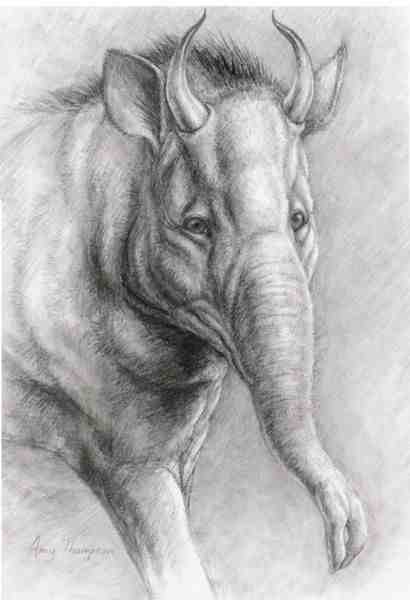
Mulefa fan art. Copyright and credit: Amy Thompson
|
Atal said, Yes. All the mulefa have this. You have, too. That is how we knew you were like us and not like the grazers, who don't have it. Even though you look so bizarre and horrible, you are like us, because you have - and again came that word that Mary couldn't hear quite clearly enough to say: something like sraf, or sarf, accompanied by a leftward flick of the trunk.
|
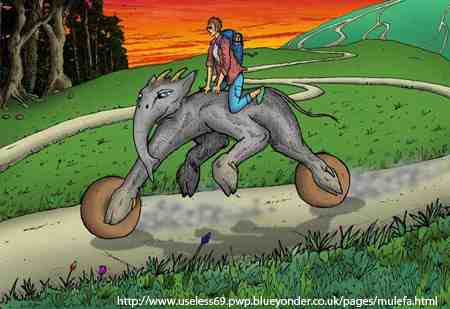
Mulefa fan art
|
Mary was excited. She had to keep herself calm enough to find the right words.
What do you know about it? Where does it come from?
From us, and from the oil, was Atal's reply, and Mary knew she meant the oil in the great seedpod wheels.
From you?
When we have grown up. But without the trees it would just vanish again. With the wheels and the oil, it stays among us.
When we have grown up... Again Mary had to keep herself from becoming incoherent. One of the things she'd begun to suspect about Shadows was that children and adults reacted to them differently, or attracted different kinds of Shadow activity. Hadn't Lyra said that the scientists in her world had discovered something like that about Dust, which was their name for Shadows? Here it was again.
And it was connected to what the Shadows had said to her on the computer screen just before she'd left her own world: whatever it was, this question, it had to do with the great change in human history symbolized in the story of Adam and Eve; with the Temptation, the Fall, Original Sin. In his investigations among fossil skulls, her colleague Oliver Payne had discovered that around thirty thousand years ago a great increase had taken place in the number of shadow particles associated with human remains. Something had happened then, some development in evolution, to make the human brain an ideal channel for amplifying their effects.
[The Amber Spyglass Chp 17, Oil And Lacquer pg 223]
Here, we are given another suggestion that a major cosmic event occurred that caused the mulefa to evolve into conscious beings. In the mulefa myth, when the mulefa Eve used the oil for the first time, she knew what she was; she knew that she was a mulefa and not an animal. The passage continues and we are told:
She said to Atal:
How long have there been mulefa?
And Atal said:
Thirty-three thousand years.
She was able to read Mary's expressions by this time, or the most obvious of them at least, and she laughed at the way Mary's jaw dropped. The mulefa's laughter was free and joyful and so infectious that Mary usually had to join in, but now she remained serious and astounded and said:
How can you know so exactly? Do you have a history of all those years?
Oh yes, said Atal. Ever since we have had the sraf, we have had memory and wakefulness. Before that, we remembered nothing.
What happened to give you the sraf?
We discovered how to use the wheels. One day a creature with no name discovered a seedpod and began to play, and as she played she -
She?
She, yes. She had no name before then. She saw a snake coiling itself through the hole in a seedpod, and the snake said...
The snake spoke to her?
No, no! It is a make-like. The story tells that the snake said, "What do you know? What do you remember? What do you see ahead?" And she said, "Nothing, nothing, nothing." So the snake said, "Put your foot through the hole in the seedpod where I was playing, and you will become wise." So she put a foot in where the snake had been. And the oil entered her blood and helped her see more clearly than before, and the first thing she saw was the sraf. It was so strange and pleasant that she wanted to share it at once with her kindred. So she and her mate took the seedpods, and they discovered that they knew who they were, they knew they were mulefa and not grazers. They gave each other names. They named themselves mulefa. They named the seed tree, and all the creatures and plants.
[The Amber Spyglass Chp 17, Oil And Lacquer pg 224]
For students who have integrated enough science, metaphysics and esoteric knowledge, the role of the snake becomes apparent once it is understood how deliveries of universal energy (plasma) arrives when operating under certain electromagnetic conditions. The extensive use of metaphors by ancient astronomer-priests to hide scientific and esoteric knowledge is well understood amongst scholars who still practice this today by their use of 'Hermetic Jargon'. In my book, Tuning the Diamonds: Electromagnetism & Spiritual Evolution, I reveal the real significance of the Egyptian god Apophis as a planetary phenomenon causing chaos by unbalancing the geomagnetic environmental and consequently the human energy field. With regard to Pullman, he seems to believe the snake was not a malevolent force but rather, a representative or an advocate of choice that allows for further human development. Somehow, it seems that humans have a choice in the evolutionary process, but this ability to choose has been demonised by a controlling authoritative Church that prefers humans to be child-like and undeveloped. Thus, once the snake arrives, and humans make the choice for greater knowledge, an evolutionary upgrade takes place, but the implications are that controllers who run certain religious establishments, think highly evolved humans are an anathema and need to be debased back into a near animal-like state to stop them being too evolved and presumably more easy to control. Regardless, where did Pullman get his ideas from that the arrival of dark matter aka dust or golden energy was the trigger for massive evolutionary change. More importantly, that the Adam and Eve myth represents the choice to evolve or not?
Final Summary and Conclusion
According to Pullman, "Dust permeates everything in the universe, and existed before we individuals did and will continue after us" (quoted in Frost, 320). As the trilogy progresses, we are informed that Dust forms consciousness and then interacts with conscious beings. Moreover, Dust formed and differentiated, on its own, into conscious, discrete beings of pure Dust long before the first conscious physical beings. These beings became the angels and the watchers, but we are not given enough information to know for sure whether these are considered as distinct entities. Moreover, the lesser angels found out that the being who describes himself as God is a fraud because he was never the original creator, just an angel. The Authority told those who came after him that he had created them, but it was a lie. [The Amber Spyglass Chp 2, Balthamos and Baruch pg 31] Interestingly, Pullman alludes to the possibility that these 'angels' are not humanoid and in the Subtle Knife, we are told that,
"...their awareness spread out beyond her like filamentary tentacles to the remotest corners of universes she had never dreamed of. . . she saw them as human-formed only because her eyes expected to. If she were to perceive their true form, they would seem more like architecture than organism, like huge structures composed of intelligence and feeling" [The Subtle Knife, Chp 6, Lighted Fliers, pg 141].
Maybe, this is a hint related to astrobiologists who think that lifeforms could have evolved into "intelligent AI-powered machines", it is difficult to imagine any other interpretation, but if this is Pullman's beliefs they are indeed very sophisticated, advanced and controversial.
Pullman's "Theology of Dust" that others have attempted to articulate, can be summed up by stating that spirituality is about how much Dust you can attract and that is a very individual matter (please excuse the pun).
Dust is a process, an interaction, as well as a particle. The ability to attract lots of Dust is the explanation for the maturity of an individual and this is associated with the dæmon, or the physical animal manifestation of the soul in Lyra's world. Conscious beings do not simply attract Dust – they also create it. "'Dust is not a constant. There's not a fixed quantity that has always been the same. Conscious beings make Dust – they renew it all the time, by thinking and feeling and reflecting, by gaining wisdom and passing it on" [The Amber Spyglass Chp 37, The Dunes 496]. This short description implies that Pullman believes Dust can be 'patterned' by humans and this takes us into interesting discussions about the nature of good and evil. Is Dust neutral or not? Can Dust be misused against humans? Was Pullman and other metaphysicians right to believe that Dust can only be attracted to those with a high moral code? If this is true then what is 'bad energy' all about? Can Dust or golden energy be corrupted and used to harm humans when directed with malevolent intent? These are questions that this trilogy does not cover at all.
Pullman suggests that humans operate with a feedback mechanism. A moral code and attitude that is life enhancing, sustaining and preserving allows you to attract more Dust. It is beyond the scope of this book to elucidate this extensively, but it is worth mentioning that people with certain types of personality disorders (narcissists, malignant narcissist, sociopaths, psychopaths), most likely cannot attract much Dust and this where the trouble starts with desperate need to obtain 2nd hand Dust in order to exist. Obviously, psychologists do not define the process of energy extraction by the need for a particular type of spiritual energy, but it is a fact that victims are those who are the most empathic. The need to extract energy from others in a parasitic manner (which I believe is 2nd hand Dust in Pullman's terminology or narcissistic supply in Sam Vaknin's terminology), where the feelings and emotions of victims is considered irrelevant, has led psychologists to believe a certain percentage of the population are not 'real humans'. The description of 'intraspecies predators', is an apt phrase coined by Dr Robert Hare, a highly respected pioneering researcher in the field of psychology. He describes psychopaths as people who use charm, manipulation, intimidation, sex and violence to control others and to satisfy their own selfish needs. It is now proven scientific fact that that there are people born with structural abnormalities in their brains. Based on the holographic brain theory, it might mean that there is absolutely no way that certain types of spiritual energy can be processed in a normal fashion and that people identified as having certain types of personality disorder are forced into being parasitical to obtain energy that is patterned with frequencies that they can process. Well, is this a new theory for the existence of evil? It is certainly a worthwhile subject for some serious contemplation.
Pullman's theology implies that the Church does not need to be involved in the process of an individual attracting Dust and of course that means the Church power strategy and business model is threatened by those who might want to accept this notion as a fundamental truth. Moreover, I think there is a real problem with intellectuals who think that Pullman is an atheist because at the end of the trilogy, the children Lyra and Will accidentally kill off The Authority or God. The Authority is actually described as being an extremely ancient being that first condensed out of the æther as an angel but who then acquired a God-complex. The Authority equates to the childish view many people have of God as an angel floating on a cloud. Quite frankly, this out-dated view of the Creator needs to be killed off.... Pullman explains that the Holy Spirit is divine spiritual energy that acts as a messenger from the Divine. What's more, he reveals normally hidden esoteric beliefs that people can become more divine by attracting more of the Holy Spirit by maintaining their passion in life. I can't see that as being the kind of talk that comes from a typical atheist and those who have bothered to read these books properly understand this quite clearly, see The identity of God for more on this subject. Pullman is currently writing The Book of Dust, but it has been in the works for a long time, so we must wait to see if he wants to share any more insights into the true nature of the Divine.
Regardless, I am quite convinced that there are far more sophisticated belief systems about the Divine that are known and understood by mystics and the intellectual elite. My suggestion is that those who are capable, need to study The Theory of Multidimensional Reality as explained in the book Reality Revealed (1978), by authors Douglas Vogt and Gary Sultan and then the ideas of the philosopher Oliver Reiser and then start looking at other religious/esoteric belief systems that do not give the impression that God is an angel sitting on a cloud. I think that Pullman has been very clever in his writing, and I think atheists have been praising his defiance of cherished religious beliefs for the wrong reasons.
Obviously, some intellectuals discussing Pullman's theology, try to provide some reassurance that Philip Pullman does not believe literally in the existence of Dust. Yet, intellectual discussions of Pullman's theology seem to falter when the role of Dust is applied to the mythical Big Bang, creation, the make-up of our reality and evolution. Analysis seems devoid of any real scientific arguments and the comparison of Dust with dark matter is not science, it is just more metaphysics. (Please note: Not all scientists agree with science philosopher Karl Popper and his definition that a scientific hypothesis has to falsifiable, otherwise it's just metaphysics.) The following is an example of writing about Pullman's theology,
Dust, then, may have been present from the beginning of the universe, but it supposedly was formed "when matter began to understand itself" because "matter loves matter." It is unclear in what sense matter "began to understand itself," because the Authority, the first angel, long preceded the arrival of the first life. In this way, matter seems to be inherently animate, and Dust is the fulfillment or representation of a sort of world spirit like that proposed by Renaissance era philosophers. Bird posits that "Dust and the universe appear to be interchangeable in that there is no distinction between the 'source' and the 'product'. . . . Thus, Pullman's conception of Dust is very like what Derrida terms 'full presence, the reassuring foundation' (Writing and Difference 292). . ." (Bird in Lenz 192). This is true, in that Dust seems to both permeate and stand apart from the normal passage of time and development of complexity, and cause and effect are confused. But while Dust may be a "reassuring foundation," the implications of Dust for human conduct, morality, and so-called theology are not immediately clear.
Dust in His Dark Materials, Essay published by J. Parry on 25th Jul 2007.
|
|
The pioneering Swedish plasma physicist, Hannes Alfvén (1908-1995), on the occasion of his acceptance of the Nobel Prize in 1970, stated, "In the beginning was the plasma" and based on a review of current scientific thinking in cosmology, many now believe the universe could be infinite and eternal. Therefore, it is impossible to be intellectual about the existence of spiritual energies or Dust without realising that scientists believe that the universe is mostly made up of energy that is completely invisible to us. It must be understood that scientists hypothesise that the PHYSICAL VISIBLE REAL UNIVERSE is only 4.6% of our TOTAL REALITY, the rest is dark matter and dark energy (STRANGE UNREALITY). But, the PHYSICAL VISIBLE REAL UNIVERSE is 99.999% plasma and therefore the vast majority of the universe is in the fundamental state of matter, which exists as highly intelligent sub-atomic particles.
|
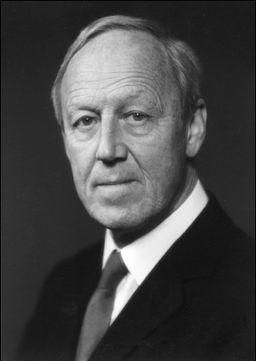
Nobel Prize winner
Hannes Alfvén
(Click image for more info)
|
|
The smaller the particle, the more intelligent it is and the only distinction that is made about Dust is that it is uncharged. This is why Pullman asserts there are "UNCOUNTABLE BILLIONS" of angels [The Subtle Knife, Chp 12, pg 248 ]. I would argue with that and say UNCOUNTABLE TRILLIONS to the power of trillions. I seriously don't believe it is possible to wax lyrical about Pullman's beliefs without understanding that we live in a plasma universe and that we can equate the existence of the Holy Spirit to the existence of highly intelligent universal energy and uncharged, normally undetectable plasma in the universe.
Moreover, intellectuals trying to turn Dust into fairy dust have another problem because it is becoming very clear that there are some humans on this planet who are more evolved than the average. It is a scientific fact that people with certain types of synæsthesia can actually see and detect more environmental energies and signals than the average person. In this regard, golden energy is just another background commodity. I am also quite happy to reveal that I have seen golden energy on my hands that appeared like a mist of tiny liquid golden globes... Simply, it is a false assumption to assume that all humans are the same and have not developed brains that are needed to process certain types of environmental information. Another example is those with electro-hypersensitivity who complain that they can see electric and magnetic fields, there are even a few rare humans with superhuman vision, the so-called 'tetrachromat'. Some neurologists might consider these abilities to be evidence that some brains have evolved to make some environmental energies and signals accessible to human consciousness. Therefore, there is no way that intellectuals can make dismissive generalisations about something they can't see themselves when psychologists and neurologists tell us that there seems to be a major flowering of consciousness in the last 40 years taking place, with millions of people with extraordinary sensory abilities that some experts believe is a signature of widespread human evolution.
This book review covers three books and the subject matter has very interesting parallels to the new phenomenon of space weather and energy driven evolutionary change. Combined with metaphysical/esoteric beliefs, Pullman's trilogy is worthy of some serious consideration concerning the central theme of Dust and the reality of humans being effected by the arrival of cosmic energy from space. This is especially pertinent as press releases from space agencies inform the world that Earth's protection against the cosmic elements is waning. It is also known that some in the New Age milieu have taken matters into their own hands are harnessing New Energy combined with the power of intent to build up their own energy fields to act as a shield that filters cosmic energies, thus allowing them the best opportunity to evolve according to a divine blueprint. Essentially, Pullman has touched on this subject of the human energy field by stating that, "they would seem to be made of living gold. They would seem the true image of what human beings always could be, once they had come into their inheritance." [The Amber Spyglass Chp 35, Over the Hills and Far Away 473] Yet, it's far more complicated than humans carrying around a sprinkling of golden energy, as various modern day mystics and sensitives have revealed. The human energy field is layered and operates with purpose that can be scientifically explained. The most important thing to know is that there are claims that the human energy field is evolving but the implications have to be the subject of some serious scrutiny and so far that has been lacking.
Finally, in reading various articles and reviews to get a feel for the typical type of response to Pullman's classic work, I came across someone who had highlighted Joni Mitchell's song
Woodstock, and the words of the chorus are:
We are stardust,
We are golden.
And we've got to get ourselves,
Back to the garden.
Somehow Pullman's work has evoked this same response within me and I hope this book review will help others see the underlying message of Pullman's story of worlds where living beings are made conscious by their relationship with divine energy aka Dust. Moreover, after reading this review, the explanation might be clearer as to why Philip Pullman has been called many things, including the "most significant" and the "most dangerous" writer in Britain.
Susan Joy Rennison
9th October 2012
References
-
Literature Study Guide: His Dark Materials - Philip Pullman, Spark Notes, link
-
Children's writer Philip Pullman ranked second on US banned books list: Author of His Dark Materials trilogy included on American Library Association's 2008 list, The Guardian, 30 September 2009, link
-
H. Brown, Page in the Life: Philip Pullman: The novelist Philip Pullman tells Helen Brown about his Victorian
adventures - and reveals he is working on two new His Dark Materials stories
, The Telegraph, 17 Oct 2011, Link
-
R. Butler, The Art of Darkness: An Interview with Philip Pullman, More Intelligent Life, December 3rd 2007,
Link
-
Philip Pullman Interviews, Philip Pullman Website, link
- ChloéBoffy, Philip Pullman's "His Dark Materials" (2006), cittagazze.com, Link
-
The Book of Dust, The Bridge of Stars, link
-
J. Parry, Dust in His Dark Materials, hisdarkmaterials.org, 25th Jul 2007,
Link
-
J F R Coates, The identity of God, hisdarkmaterials.org, Link
- T Pætkau, His Dark Materials: The Golden Compass, The Open Critic, link
-
A Breeze from the Stars: NASA spacecraft are monitoring an interstellar wind coming from the constellation Ophiuchus, NASA Science News, December 17, 2004, link
-
NASA's Fermi Telescope Finds Giant Structure in our Galaxy, NASA Science News, 9th November 2010,
Link
-
Meng Su, Tracy R. Slatyer, Douglas P. Finkbeiner, Giant Gamma-ray Bubbles from
Fermi-LAT: AGN Activity or Bipolar Galactic Wind?, Astrophys.J.724:1044-1082,2010, link
-
The Plasma Universe Website, Link
-
A. Watts, Scientist quits: 'I don't want to remain a member of an organization that …screws up science that badly (Hermetic Jargon), Watts Up With That, 12th February 2010, Link
-
P. Woit, Susskind Interview at New Scientist, Not Even Wrong, Department of Mathematics
Columbia University, December 15, 2005, Link
-
Power Animals, Wikipedia, the free encyclopedia, Link
-
"Without Conscience" Robert Hare's Web Site devoted to the study of Psychopathy,
Link
-
Sam Vaknin, Author of Malignant Self Love - Narcissism Revisited,
Link
-
S. J. Rennison, Tuning the Diamonds: Electromagnetism & Spiritual Evolution, Joyfire Publishing, 2006, 2008, 2010, 2012, Link
Back to Joyfire Book Review Index
Back to Sitemap
|
|
 Home
Joyfire Science & Metaphysics Integration
Copyright © 2003 – 2025. All rights reserved.
|
|
Susan Joy Rennison quotes:
“Space Weather is now a fact of life.”
“We are all astronauts now!”
Tuning The Diamonds,
September 2006
“We must spiritually evolve as part of the new terms & conditions for living on Earth.”
Joyfire Tour – Evolutionary Change, December 2006
“Space Weather will force many changes in how we do business on this planet.”
News of the Imbalance,
April 2007
NASA Press Release:
“Earth and space are about to come into contact in a way that's new to human history.”
“We're on the threshold of a new era in which space weather can be as influential in our daily lives as ordinary terrestrial weather.”
As the Sun Awakens, NASA Keeps a Wary Eye on Space Weather
NASA News, 4th June 2010
White House Executive Order:
“Space weather has the potential to simultaneously affect and disrupt health and safety across entire continents. Successfully preparing for space weather events is an all-of-nation endeavor that requires partnerships across governments, emergency managers, academia, the media, the insurance industry, non-profits, and the private sector.”
Executive Order –– Coordinating Efforts to Prepare the Nation for Space Weather Events
The White House, 13th October 2016
|
Missing Images?
How to fix web page
images not showing.
Link
Search Engines
Censor Images
From This Website!
Use Yandex.com!
Geomagnetic storm header Credit: Jüri Voit

Has the article disappeared? Try the Way Back Machine
Internet Archive
Click image for link
|
This website is best viewed with the FireFox browser, you can download it here
 click icon
click icon
|
|



